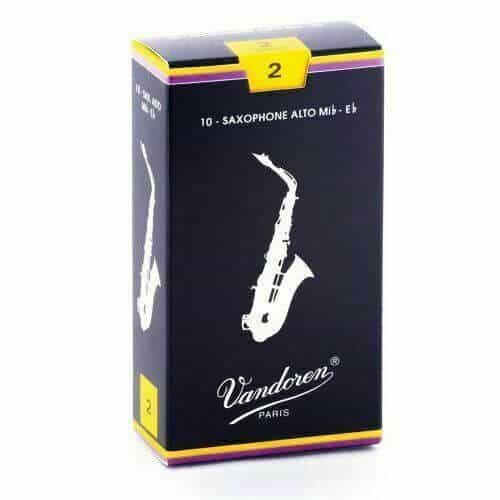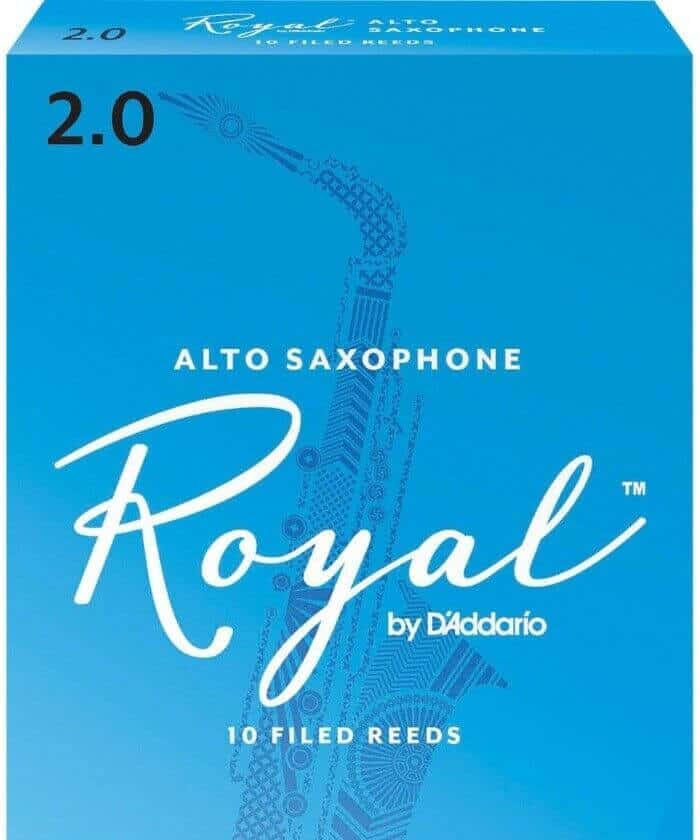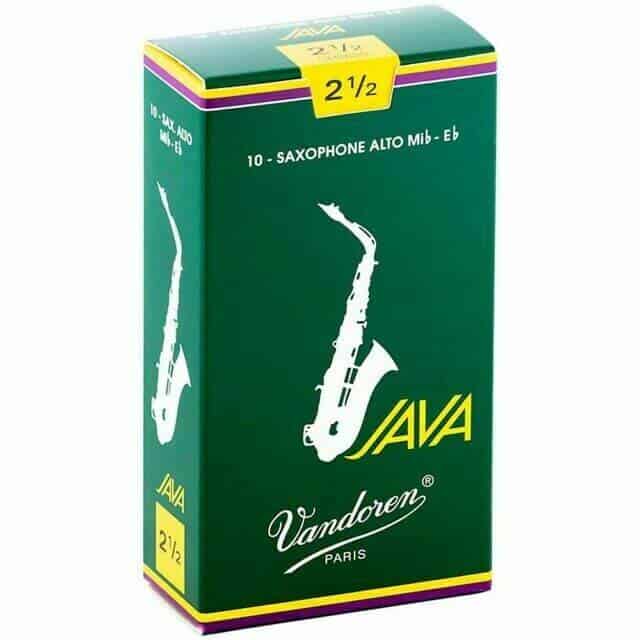When it comes to playing a saxophone, it’s not only the horn that makes the difference, but the whole setup. This includes the mouthpiece, the ligature, the size of the bell, and of course, the reed that the player is using.
In this article, we’ll go over the best alto sax reeds for the most popular type of sax for beginners and sax enthusiasts. Let’s delve into it!
In a Hurry? Here are our top 3 picks:
| Image | Product | Details | Price |
|---|---|---|---|
 |
Vandoren SR213 | Best Overall | Check Price |
 |
D’Addario Royal Alto Sax Reeds | Runner-Up | Check Price |
 |
Vandoren SR2625 Alto Sax JAVA Reeds | Best for Bright Jazz | Check Price |
Table of Contents
The 6 Best Alto Sax Reeds
1. Best Overall: Vandoren SR213
It’s no surprise that a Vandoren reed gets the number one spot on our list. This French manufacturer is as well-established in the world of reed as Selmer Paris is in the world of saxophones.
The ultimate combination with an alto sax would be the 3-strength reed (SR213), though it’s available from strengths 1.5 all the way to 5, with 0.5 incrementals. These come with incredible flexibility, allowing the player to hit either legato or staccato executions of large intervals without losing any richness of tone. And as Vandoren reeds are known, the sound it produces is clear and full-bodied.
The Vandoren SR213 is a reed that you can use while playing for concert bands, UIL solos, and ensemble contents. Their quality is beyond a jazz band or small combo, as they have top-notch response across all registers. A saxophonist can even hit a pianissimo attack properly, even with high notes.
With a very thin tip, the Vandoren SR213 produces a mellow sound with a warm tone. It’s both crisp and clear, leaving no space for raspy or throaty tones.
And since they’re made of cane, each reed comes in a sealed “Flow Pack” that isolates it from humidity and keeps it fresh and ready to play.
Pros
- Crisp and clear sound
- Excellent value for price
- Wide range of playability
- Consistent tone and response across all registers
Cons
- Each reed doesn’t last very long
- Might take extra time to break in
2 . Runner-up: D’Addario Royal Alto Sax Reeds
D’Addario is a well-established name, especially when it comes to reliable reeds of affordable price tags. This one is an excellent choice for both players that want to hit jazzy tones as well as classical pieces.
I have to admit, one of the most appealing things about this brand and product is that the reeds are available in standard pack of 10, pack of 25, and a practical pack of 3. Moreover, the strengths start from 1.0 to 5.0 with 0.5 increments, so both beginners and more seasoned players can find something that suits their playing style.
Compared to other options it may not have the smoothest sound, but it’s easy to play as it doesn’t require the use of so much air. That’s why it’s a favorite among novices.
And the fact that they’re filed, or French cut, means that they’ll pair perfectly with smaller saxophones, which is why they’re one of the best alto sax reeds out there.
Pros
- Wide range
- Suits both jazz and classical music
- Easy to play
Cons
- Don’t last very long
3. Best Alto Sax Reeds for Students: Cecilio Alto Saxophone Reeds
The name Cecilio has been strongly tied to students and marching bands as this company is famous for its affordable units that can withstand the wear and tear of a student instrument. Naturally, Cecilio offers reeds that offer the same ideal balance between affordability and functionality.
These reeds make a great choice for practice and for those players who go through their reeds quicker than the average. At less than $15 for a pack of 20, you definitely don’t have to worry about the durability of the reed, and you don’t have to put so much effort into keeping them in shape.
Also, a nice touch from Cecilio with these reeds is that each one comes in its own plastic case to protect the cane from humidity.
Pros
- Bang for the buck
- Easy to play
Cons
- Sound is not as crispy as other options
- Break easily
4. Best Synthetic Alto Sax Reeds: Legere Signature Alto Sax Reed Signature 3.0
If you want to spare yourself the time it takes to break in a new cane reed and don’t want to spend a couple of minutes warming up before you get to playing, the Legere ASSS3.0 is an ideal synthetic choice.
Cane reeds sound more natural, but this one comes with a very similar sound, if not the same, as moist cane.
You can use the Legere ASSS3.0 to play any tone color, bright or dark. Not only that, but it does offer breakthrough performance compared to synthetic reels with its flexibility and steadfast projection.
I have to admit, touching $30 seems like a lot for what sound quality it has to offer. But given the durability of a synthetic reed, it’s not too shabby an investment.
Pros
- Plays both dark and bright tones very well
- Offers a good balance of everything
- Durable
Cons
- Low resistance
- Sub-par response
- A little pricey
5. Best Alto Sax Reeds for Bright Jazz: Vandoren SR2625 Alto Sax JAVA Reeds
Vandoren definitely deserves a second appearance on the list, and the SR2625 variant is an excellent choice for saxophonists that want to hit the brightest jazz notes with an unfiled reed capable of playing extremely powerfully.
These reeds are easy to play as they’re made of cane, and they provide the perfect balance between projection and flexibility.
Despite being a little more pricey than other options, the JAVA green gives you all the response you need. And no matter the length of the palette, you’ll find that this reed vibrates over the entire length.
Part of the luxury, of course, dictates that each reed in the pack (of 10) comes sealed with a “Flow Pack” to protect from humidity and keep it fresh.
It’s worth mentioning that there’s also a red variant of the JAVA reeds, which is more suitable for deeper tones with higher resonance. If you’re still exploring, you can opt for this 4-pack option by Vandoren that allows you to test the JAVA green, JAVA red, ZZ, and V16.
Pros
- Powerful sound
- Bright tones
- Solid projection
Cons
- Sound can be a little inconsistent due to cane material
- Doesn’t provide as much resonance as other options
6. Budget Pick: D’Addario Rico Alto Sax Reeds
Yet another D’Addario pick, but this one is our go-to choice is the RJA1020 with a strength of 2 for ultimate playability. Still, there are other strengths ranging from 1.5 to 4.0, with 0.5 increments.
The Rico reed is a popular choice among beginners as it’s a cane one, which means that after warming it up, the player gets more control over the reed. Not to mention, it’s quite affordable, at less than $25 for a pack of 10.
If you’re looking to play some high-pitch tunes on an alto sax and want a dependable option, the D’Addario Rico RJA1020 would serve you well.
Pros
- Great value for the money
- Suits beginners
- Works well with professional players
Cons
- Have to be changed often
How to Choose a Reed?
When you’re looking for a reed, there are a couple of factors that you should pay attention to, no matter whether the reed is for an alto, sopano, tenor, or bari horn. In this section, we’ll go over the main points of focus that can help you decide on the reed that suits you best.
Brand
Naturally, the brand of your reed will affect many aspects, from playability and feel to durability.
Related: The Top 9 Alto Saxophones This Year
Material
The material of the reed itself has a huge effect on how it sounds. In fact, it’s one of the factors that plays a huge role.
Your reed will be made of either natural cane (wood) or plastics or rubber (synthetic). Synthetic ones are more adaptive, but the cane ones are easier to handle and control.
Synthetic reeds beat cane ones in that they are easier to maintain, can be played outside, don’t need time to get in shape for playing, and are more durable.
On the other hand, cane reeds might need a little time to warm up, but once they’re up and running you get so much more out of them. You have more capability to sand some notes in order for them to sound lower or higher, which gives you more control over the music you play.
And despite not being so durable, pros usually prefer cane reeds for what control the player has over the sound. And compared to the price of synthetic reeds, they’re not too pricey.
Moreover, nowadays you can find plasticover reeds that combine the best of both worlds. They give you the control of a cane reed with the durability of a synthetic one thanks to the plasticover coating.
Strength
The rule of thumb is that the higher the strength of the reel, the better its tone production is, and thus, the better the sound of the sax. However, this also means that the thicker it is, and therefore, harder to play.
That’s why beginners benefit from opting for lower strength numbers, typically a 2 or 2.5-strength reed would serve a novice well in their learning process. This is especially because lower strengths produce brighter tones, which are generally easier to play, which is why they’re good for entry-level players.
As the player gets comfortable getting a certain reed strength to vibrate, they can move up the strength ladder to the more difficult and accurate ones.
Filed vs. Unfiled
In other words, do you want that extra strip of bark removed or not? If you’re looking for more flexibility in your playing and fast response, you definitely will, which is why a filed reed would be the better option for you.
On the other hand, if you want your tones to sound more powerful and you’re looking to pair your reed with larger horns (tenor, baritone, and bass), then an unfiled reed is the way to go.
Price
You can get a box of 10 reeds for $23 and only one reed for $33, depending on the quality, durability, and brand. But like any other purchase, the more you invest into your reed, the more durable it will be and the better the sound quality it will give you.
The durability of a reed depends on how much you play it and how well you maintain it, but holding all variables constant, the material is the deciding factor. Plastic reeds last longer, which is why they’re typically more expensive, while cane ones are more affordable but will require changing (and breaking in) every 1-3 weeks.
FAQs
Are Softer Reeds Better than Harder Ones?
One of the magical things about music is that there’s no right or wrong, no better or worse. It depends on your playing style. As far as the advantages of softer reeds, they’re easier to play for beginners, and give pros a high degree of flexibility that allows them to have more control over the flatness or sharpness of the tone.
Conclusion
To wrap it up, picking the best alto sax reed would require that you decide a couple of things, like what type of music you’re looking to play, the budget you’re willing to invest, and how often you’re okay with changing the reed.
A good choice with all aspects in mind would be the Vandoren SR213. It’s playable, offers a wide range and consistency in any register.
If you’re looking for something that comes close in quality but costs less, the D’Addario Royal (Blue Box) is a worthy contender. Besides being easy to play, it suits both jazz and classical playing styles, which is top-notch versatility.
On the other hand, if you’re not looking for excellent quality but something that’s versatile and budget-friendly, nothing can compete with Cecilio for this job.
Finally, if you can’t be bothered with the hassle and occasional inconsistencies of cane reeds, the Legere Signature ASSS3.0 is definitely worth a look.







